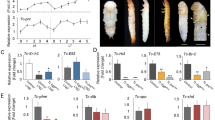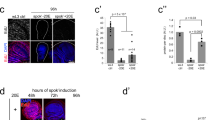Abstract
THE process by which insects harden and darken their exoskeletons after ecdysis (sclerotization) has been studied extensively1. It is believed that ecdysone controls sclerotization in dipteran puparia by inducing synthesis in the epidermis of an enzyme (DOPA decarboxylase) which catalyses the key step in the biosynthesis of the sclerotizing agent (N-acetyl dopamine) from L-p-tyrosine2. At the imaginal ecdysis of many insects (Diptera, Lepidoptera and Orthoptera) another hormone, a polypeptide called the “tanning hormone” (bursicon), is involved3. The work described here concerns the little known4 mode of action of the tanning hormone.
This is a preview of subscription content, access via your institution
Access options
Subscribe to this journal
Receive 51 print issues and online access
$199.00 per year
only $3.90 per issue
Buy this article
- Purchase on Springer Link
- Instant access to full article PDF
Prices may be subject to local taxes which are calculated during checkout
Similar content being viewed by others
References
Pryor, M. G. M., in Comparative Biochemistry (edit. by Florkin, M., and Mason, H. S.), 4, chap. 8, 371 (Academic Press, London, 1962); Cottrell, C. B., Adv. Insect Physiol., 2, 175 (1964); Brunet, P. C. J., Endeavour, 26, 68 (1967).
Karlson, P., J. Cell Comp. Physiol., 66, 69 (1965); Karlson, P., and Sekeris, C. E., Biochim. Biophys. Acta, 63, 489 (1962); Sekeris, C. E., in Mechanisms of Hormone Action (edit. by Karlson, P.), 149 (Academic Press, New York, 1965).
Cottrell, C. B., J. Exp. Biol., 39, 395 (1962); Fraenkel, G. S., and Hsiao, C., J. Insect Physiol., 11, 513 (1965); Mills, R. R., Mathur, R. B., and Guerra, A. A., J. Insect Physiol., 11, 1047 (1965).
Mills, R. R., Androuny, S., and Fox, F. R., J. Insect Physiol., 14, 603 (1968); Whitehead, D. L., Proc. Intern. Symp. Insect Endocrines, Section III, Brno, Czechoslovakia (1966); Seligman, I. M., thesis, Univ. Illinois, University Microfilms No. 68–12, 192 (1968).
Mills, R. R., J. Insect Physiol., 12, 275 (1966).
Mills, R. R., and Whitehead, D. L., J. Insect Physiol., 16 (in the press).
Jones, J. C., Amer. Zool., 2, 209 (1962); and in Physiology of Insects (edit. by Rockstein, M., III), chap. 1 (Academic Press, New York, 1964).
Seligman, I. M., Friedman, S., and Fraenkel, G. S., J. Insect Physiol., 15, 553 (1969).
Author information
Authors and Affiliations
Rights and permissions
About this article
Cite this article
WHITEHEAD, D. New Evidence for the Control Mechanism of Sclerotization in Insects. Nature 224, 721–723 (1969). https://doi.org/10.1038/224721a0
Received:
Revised:
Issue Date:
DOI: https://doi.org/10.1038/224721a0
This article is cited by
-
Induction of epidermal cyclic AMP by bursicon in mealworm,Tenebrio molitor
Experientia (1979)
Comments
By submitting a comment you agree to abide by our Terms and Community Guidelines. If you find something abusive or that does not comply with our terms or guidelines please flag it as inappropriate.



